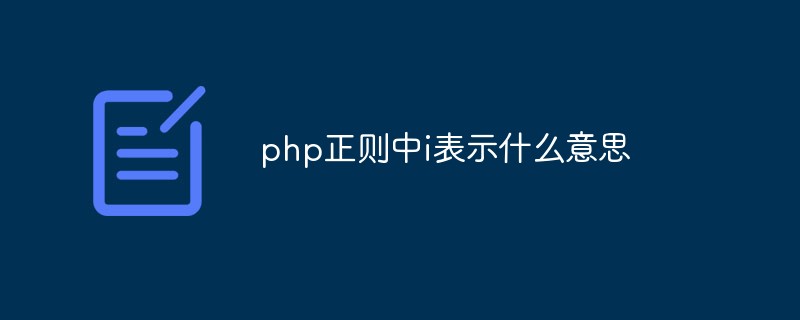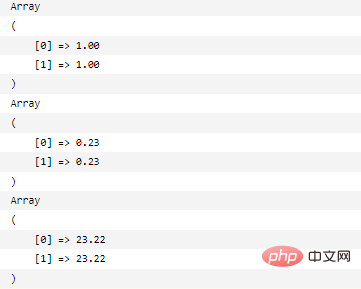What does i mean in php regular code?
在PHP中,正则表达式的“i”是“in-casesensitive”的缩写,表示的是“区分大小写”的意思,是正则表达式中的修正符;在正则表达式中设定此修正符时,表示正则表达式进行匹配的字符将同时匹配大小写字母,语法为“/ 匹配条件 /i”。

本文操作环境:Windows10系统、PHP7.1版、Dell G3电脑
php正则中i表示什么意思
这里的 i 是正则表达式
i: 表示in-casesensitive,即大小写不敏感
如果设定此修正符,模式中的字符将同时匹配大小写字母。
例如:
$reg = '/ {5} / i '拓展知识:
正则表达式就是一个匹配的模式,正则表达式本身也就是一个字符串(有一些语法规则,特殊符号组成)
正则表达式这个字符串一定要在对应的函数中使用才有意义(分割,替换函数结合使用)
1、定界符 / /
2、原子 最小的一个匹配单元(放在 / / 中,在正则表达式中,至少有一个。例如:$reg = '/ 7 /' )
3、元字符 元字符是不能单独使用的,用来修饰元子的,用来扩展原子功能和限字的做补充说明(协助定界符中 例如:$reg = '/{5}/' )
4、模式修正符 修正,对模式(正则)修正(写在定界符的外面,写在右边 例如: $reg = '/ {5} / i ' 中的i)
示例如下:
1、非空匹配 ‘/.+/’
2、浮点数匹配(保留2位)‘/(?!0\.00)(\d+\.\d{2}$)/’
$subject = ['1.00', '2.345', '0.23', '234', '23.22', '0.00'];
$matche = [];
for ($i = 0; $i < count($subject); $i++){
if(preg_match('/(?!0\.00)(\d+\.\d{2}$)/', $subject[$i], $matche)){
show($matche);
}
}结果:

3、手机号码
‘/^1(3|4|7|8)\d{9}$/’4、Email地址
‘/^([0-9A-Za-z\\-_\\.]+)@([0-9a-z]+\\.[a-z]{2,3}(\\.[a-z]{2})?)$/i’或者
‘/^\w+(\.\w+)*@\w+(\.\w+)+$/’
5、常见URL地址
'/^(https?://)?(\w\.)+[a-zA-Z]+$/'
推荐学习:《PHP视频教程》
The above is the detailed content of What does i mean in php regular code?. For more information, please follow other related articles on the PHP Chinese website!

Hot AI Tools

Undresser.AI Undress
AI-powered app for creating realistic nude photos

AI Clothes Remover
Online AI tool for removing clothes from photos.

Undress AI Tool
Undress images for free

Clothoff.io
AI clothes remover

Video Face Swap
Swap faces in any video effortlessly with our completely free AI face swap tool!

Hot Article

Hot Tools

Notepad++7.3.1
Easy-to-use and free code editor

SublimeText3 Chinese version
Chinese version, very easy to use

Zend Studio 13.0.1
Powerful PHP integrated development environment

Dreamweaver CS6
Visual web development tools

SublimeText3 Mac version
God-level code editing software (SublimeText3)

Hot Topics
 1677
1677
 14
14
 1431
1431
 52
52
 1334
1334
 25
25
 1279
1279
 29
29
 1257
1257
 24
24
 PHP and Python: Different Paradigms Explained
Apr 18, 2025 am 12:26 AM
PHP and Python: Different Paradigms Explained
Apr 18, 2025 am 12:26 AM
PHP is mainly procedural programming, but also supports object-oriented programming (OOP); Python supports a variety of paradigms, including OOP, functional and procedural programming. PHP is suitable for web development, and Python is suitable for a variety of applications such as data analysis and machine learning.
 Choosing Between PHP and Python: A Guide
Apr 18, 2025 am 12:24 AM
Choosing Between PHP and Python: A Guide
Apr 18, 2025 am 12:24 AM
PHP is suitable for web development and rapid prototyping, and Python is suitable for data science and machine learning. 1.PHP is used for dynamic web development, with simple syntax and suitable for rapid development. 2. Python has concise syntax, is suitable for multiple fields, and has a strong library ecosystem.
 PHP and Python: A Deep Dive into Their History
Apr 18, 2025 am 12:25 AM
PHP and Python: A Deep Dive into Their History
Apr 18, 2025 am 12:25 AM
PHP originated in 1994 and was developed by RasmusLerdorf. It was originally used to track website visitors and gradually evolved into a server-side scripting language and was widely used in web development. Python was developed by Guidovan Rossum in the late 1980s and was first released in 1991. It emphasizes code readability and simplicity, and is suitable for scientific computing, data analysis and other fields.
 PHP's Impact: Web Development and Beyond
Apr 18, 2025 am 12:10 AM
PHP's Impact: Web Development and Beyond
Apr 18, 2025 am 12:10 AM
PHPhassignificantlyimpactedwebdevelopmentandextendsbeyondit.1)ItpowersmajorplatformslikeWordPressandexcelsindatabaseinteractions.2)PHP'sadaptabilityallowsittoscaleforlargeapplicationsusingframeworkslikeLaravel.3)Beyondweb,PHPisusedincommand-linescrip
 PHP vs. Python: Use Cases and Applications
Apr 17, 2025 am 12:23 AM
PHP vs. Python: Use Cases and Applications
Apr 17, 2025 am 12:23 AM
PHP is suitable for web development and content management systems, and Python is suitable for data science, machine learning and automation scripts. 1.PHP performs well in building fast and scalable websites and applications and is commonly used in CMS such as WordPress. 2. Python has performed outstandingly in the fields of data science and machine learning, with rich libraries such as NumPy and TensorFlow.
 The Continued Use of PHP: Reasons for Its Endurance
Apr 19, 2025 am 12:23 AM
The Continued Use of PHP: Reasons for Its Endurance
Apr 19, 2025 am 12:23 AM
What’s still popular is the ease of use, flexibility and a strong ecosystem. 1) Ease of use and simple syntax make it the first choice for beginners. 2) Closely integrated with web development, excellent interaction with HTTP requests and database. 3) The huge ecosystem provides a wealth of tools and libraries. 4) Active community and open source nature adapts them to new needs and technology trends.
 PHP: An Introduction to the Server-Side Scripting Language
Apr 16, 2025 am 12:18 AM
PHP: An Introduction to the Server-Side Scripting Language
Apr 16, 2025 am 12:18 AM
PHP is a server-side scripting language used for dynamic web development and server-side applications. 1.PHP is an interpreted language that does not require compilation and is suitable for rapid development. 2. PHP code is embedded in HTML, making it easy to develop web pages. 3. PHP processes server-side logic, generates HTML output, and supports user interaction and data processing. 4. PHP can interact with the database, process form submission, and execute server-side tasks.
 PHP and the Web: Exploring its Long-Term Impact
Apr 16, 2025 am 12:17 AM
PHP and the Web: Exploring its Long-Term Impact
Apr 16, 2025 am 12:17 AM
PHP has shaped the network over the past few decades and will continue to play an important role in web development. 1) PHP originated in 1994 and has become the first choice for developers due to its ease of use and seamless integration with MySQL. 2) Its core functions include generating dynamic content and integrating with the database, allowing the website to be updated in real time and displayed in personalized manner. 3) The wide application and ecosystem of PHP have driven its long-term impact, but it also faces version updates and security challenges. 4) Performance improvements in recent years, such as the release of PHP7, enable it to compete with modern languages. 5) In the future, PHP needs to deal with new challenges such as containerization and microservices, but its flexibility and active community make it adaptable.




